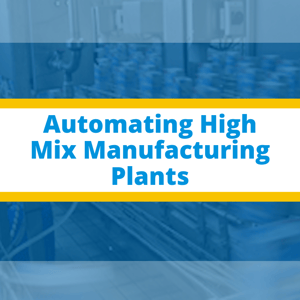 The manufacturing process for a single product can be modified much easier in order to improve its efficiency and productivity, compared to a plant floor where several different products are being produced. Higher Return on Investment is the prime motivation for automation, and improving the parameter becomes more complex as the production capacity increases in difficulty.
The manufacturing process for a single product can be modified much easier in order to improve its efficiency and productivity, compared to a plant floor where several different products are being produced. Higher Return on Investment is the prime motivation for automation, and improving the parameter becomes more complex as the production capacity increases in difficulty.
A high mix manufacturing plant is composed of several parts, each having different processes, e.g. CNC machining, visual inspection, stamping, documentation, etc. Automation is usually supplemented by interventions and guidance from human operators, while eliminating the former requires considerable investment.
Typical high mix processes and the breakdown of their aspects are:
|
Process |
Human Factor |
Challenges |
|
CNC Machining of parts of varying sizes |
Fixturing and removing each part |
Gripping mechanisms have to be changed as each part’s geometry varies |
|
Visual inspection of assembly lines |
Pictures must be taken from various angles |
The camera’s configurations may need to be changed depending on the light intensity, brightness, depth requirements. |
|
Packaging several sizes of parts |
Picking up parts and placing them on a conveyor belt |
Optimal packing configurations may be different as the dimensions change |
At the very base of all high-mix operations is the concept of changeover time that must be considered and eliminated partially or completely through automation.
Traditional Automation Benefits
Industrial robots, conveyors, cartesian robots, turnkey machines, etc. are all options that can be utilized for fixed automation. The negative aspect of such an implementation is lack of flexibility as the machine would be able to handle a certain range of sizes.
However, such an implementation is effective for a certain range of products and due to its “tailored” nature can handle the particular line of products with precision. In a high-mix system, fixed automation generally helps deal with a certain range of products when investment is kept low or allows the entire range of products to be dealt through heavy investments, with the former resulting in a lower ROI.
Robots as a Platform
Robots as platform solutions allow the entirety of a company’s product lineup to be dealt with. Instead of tying a robotic implementation to a specific process, RaaP allows them to be used for multiple processes as per the needs of the day. This allows them to be deployed in high-mix environments where the requirements change as the product or application changes. As a result, the changeover time is reduced, boosting the economic efficiency of the plant.
In plants where a high degree of manual interruptions is required to keep the automated machines running smoothly, a collaborative robot-based solution would be much more viable. Cobots are designed specifically to work with humans and/or aid them carry out laborious tasks safely, reliably and efficiently.
A practical upgradation methodology would be to follow a modular approach and introduce RaaP and cobots for processes that show the greatest potential for improvement. A complete overhaul of multiple production lines would decrease the ROI and carry the risk of abrupt production losses in case the new implementations fail to work as expected.
Interested in learning more? Visit our website www.premierautomation.com, or talk to one of our specialists today.




